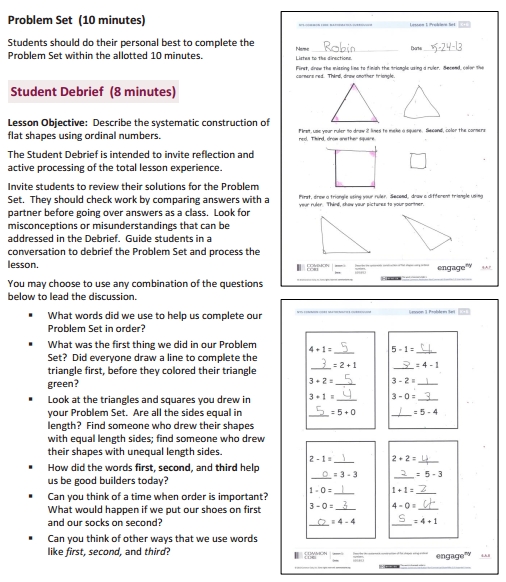Kindergarten Full Mathematics Curriculum
This is the Kindergarten Mathematics Curriculum for New York Common Core, covering: representing, relating, and operating on whole numbers; describing shapes and space. It provides multiple learning/teaching Modules, each with Topics, which in turn have one or more Lessons. Each lesson contains a Problem Set, Exit ticket, and Homework. Mid-module and end-of-module assessments (with answers) are included in each full module. Linked below also are Answer Keys for lesson Assessments, and zip files of all lessons in Word doc format (for editing, if needed). Also available are the curricula for grades 1 and 2 and grades 3 and 4 of this math series.
Kindergarten Math Curriculum
Update: Eureka Math has separated these Kindergarten math modules into separate pdf topic files to make them easier to use, and they have also included a variety of supplementary materials. You can view and download everything in Kindergarten Eureka Math here.
Kindergarten – Math Module 1 (Answer keys) (Module 1 Lesson docs in zip)
Numbers To 10 – The meaning of numbers to 10; patterns of “1 more” and “1 less”; addition within 5.
- Topic A: Attributes of Two Related Objects
- Topic B: Classify to Make Categories and Count
- Topic C: Numbers to 5 in Different Configurations, Math Drawings, and Expressions
- Topic D: The Concept of Zero and Working with Numbers 0–5
- Topic E: Working with Numbers 6–8 in Different Configurations
- Topic F: Working with Numbers 9–10 in Different Configurations
- Topic G: One More with Numbers 0–10
- Topic H: One Less with Numbers 0–10
Kindergarten – Math Module 2 (Answer keys) (Module 2 Lesson docs in zip)
Two-Dimensional and Three-Dimensional Shapes – Identify and describe two-dimensional and three-dimensional shapes.
- Topic A: Two-Dimensional Flat Shapes
- Topic B: Three-Dimensional Solid Shapes
- Topic C: Two-Dimensional and Three-Dimensional Shapes
Kindergarten – Math Module 3 (Answer keys) (Module 3 Lesson docs in zip)
Comparison Of Length, Weight, Capacity, and Numbers To 10 – Experiment with comparison of length, weight and capacity to build the meaning of the word “than”.
- Topic A: Comparison of Length and Height
- Topic B: Comparison of Length and Height of Linking Cube Sticks Within
- Topic C: Comparison of Weight
- Topic D: Comparison of Volume
- Topic E: Are There Enough?
- Topic F: Comparison of Sets Within
- Topic G: Comparison of Numerals
- Topic H: Clarification of Measurable Attributes
Kindergarten – Math Module 4 (Answer keys) (Module 4 Lesson docs in zip)
Number Pairs, Addition and Subtraction To 10 – Reason about and solve addition and subtraction expressions and equations to 10.
- Topic A: Compositions and Decompositions of 2, 3, 4, and 5
- Topic B: Decompositions of 6, 7, and 8 into Number Pairs
- Topic C: Addition with Totals of 6, 7, and 8
- Topic D: Subtraction from Numbers to 8
- Topic E: Decompositions of 9 and 10 into Number Pairs
- Topic F: Addition with Totals of 9 and 10
- Topic G: Subtraction from 9 and 10
- Topic H: Patterns with Adding 0 and 1 and Making 10
Kindergarten – Math Module 5 (Answer keys) (Module 5 Lesson docs zip file)
Numbers 10-20; Count To 100 By Ones and Tens – Clarify the meaning of the 10 ones and some ones within a teen number.
- Topic A: Count 10 Ones and Some Ones
- Topic B: Compose Numbers 11–20 from 10 Ones and Some Ones; Represent and Write Teen Numbers
- Topic C: Decompose Numbers 11–20, and Count to Answer “How Many?” Questions in Varied Configurations
- Topic D: Extend the Say Ten and Regular Count Sequence to 100
- Topic E: Represent and Apply Compositions and Decompositions of Teen Numbers
Kindergarten – Math Module 6 (Answer keys) (Module 6 Lesson docs in zip)
Analyzing, Comparing, and Composing Shapes – Understand area through composition of geometric figures.
- Topic A: Building and Drawing Flat and Solid Shapes
- Topic B: Composing and Decomposing Shapes
-love learning -your best ed lessons guide, Scott





3 Comments